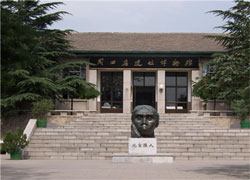Zhoukoudian Peking Man Site
The Peking Man Site is located in a cave on Dragon Bone Mountain at Zhoukoudian, about 48 kilometers southwest of Beijing. It is the most widely known hominid site in the world.
In 1918, Anderson, a famous Swedish scientist made a survey at Zhoukoudian and found a lot of rodent fossils. In 1921, the excavations at Zhoukoudian were directed by Anderson and an Austrian paleontologist Zdansky, and the first hominid remains were found.
 In 1929, Pei Wenzhong, a Chinese archaeologist discovered the first complete homo erectus skull cap on Dragon Bone Mountain, which was then named the Peking Man. This discovery provided concrete evidence for the existence of primitive man in the Beijing area about 500,000 years ago, and has given this site a special position in world anthropology research.
In 1929, Pei Wenzhong, a Chinese archaeologist discovered the first complete homo erectus skull cap on Dragon Bone Mountain, which was then named the Peking Man. This discovery provided concrete evidence for the existence of primitive man in the Beijing area about 500,000 years ago, and has given this site a special position in world anthropology research.
After that, more and more tourists and scientists came, and Zhoukoudian has gradually become a great tourist attraction.
So far, a total of 6 skulls, 12 fragments of skull, 15 mandibles, 157 teeth and numerous other bone segments from the bodies of about 40 humans have been excavated. The average brain volume of these people was 1,088 ml (the average for modern people is 1,400 ml).
It is estimated that their average height reached 156 cm for males and 150 cm for females. Peking Man was among the first human beings to make use of fire, and could hunt large animals. Their average life expectancy was short; it is estimated that 68.2% of them died before the age of 14, and only 4.5% reached more than 50 years.
In 1933, Upper Cave Man remains of about 18,000 years ago were discovered in the cave on top of Dragon Bone Mountain in the Zhoukoudian Peking Man Site. They were categorized as homo sapiens, late in the development of the modern human. The cave is about 4 meters high and 5 meters wide. Three entire skull caps and other incomplete bones belonging to three adults were discovered.
Needles made of bone and pendant adornments prove that the Upper Cave Man could sew clothes with animal skins as materials, and appears to be similar to modern man. In 1973, fossils of New Cave Man were discovered, and ensured the continuity and development of research at Zhoukoudian.
In June, 2005 archaeologists confirmed the fossils of the homo sapiens to be in the late period of the Upper Cave Man, which is the only evidence of human fossils of the Upper Cave Man discovered so far in Beijing. They discovered many fossils of ancient animals, 26 species of which have been identified to be mammal.
 In 1953, a museum of Peking Man was established at the site and opened to the public. To protect and conserve the Zhoukoudian Peking Man Site, the State Council announced the designation of the Zhoukoudian Peking Man Site as one of the first key cultural relic sites under state protection in 1961.
In 1953, a museum of Peking Man was established at the site and opened to the public. To protect and conserve the Zhoukoudian Peking Man Site, the State Council announced the designation of the Zhoukoudian Peking Man Site as one of the first key cultural relic sites under state protection in 1961.
In 1987, it was formally inscribed on the World Heritage List by UNESCO.
The discovery and study of Peking Man and his culture solved the controversy over whether homo erectus was ape or man, which started after the excavation of Java Man in the 19th century. In fact, ape-men appeared to be offspring of southern apes and ancestors of homo sapiens, judging from their action, culture and social organization.
This great discovery established anthropology research in China, and is invaluable for paleo-anthropological research.
Travel Information
Transport: Bus 917. Admission: 30 yuan. Open: 8:30am – 5pm.

